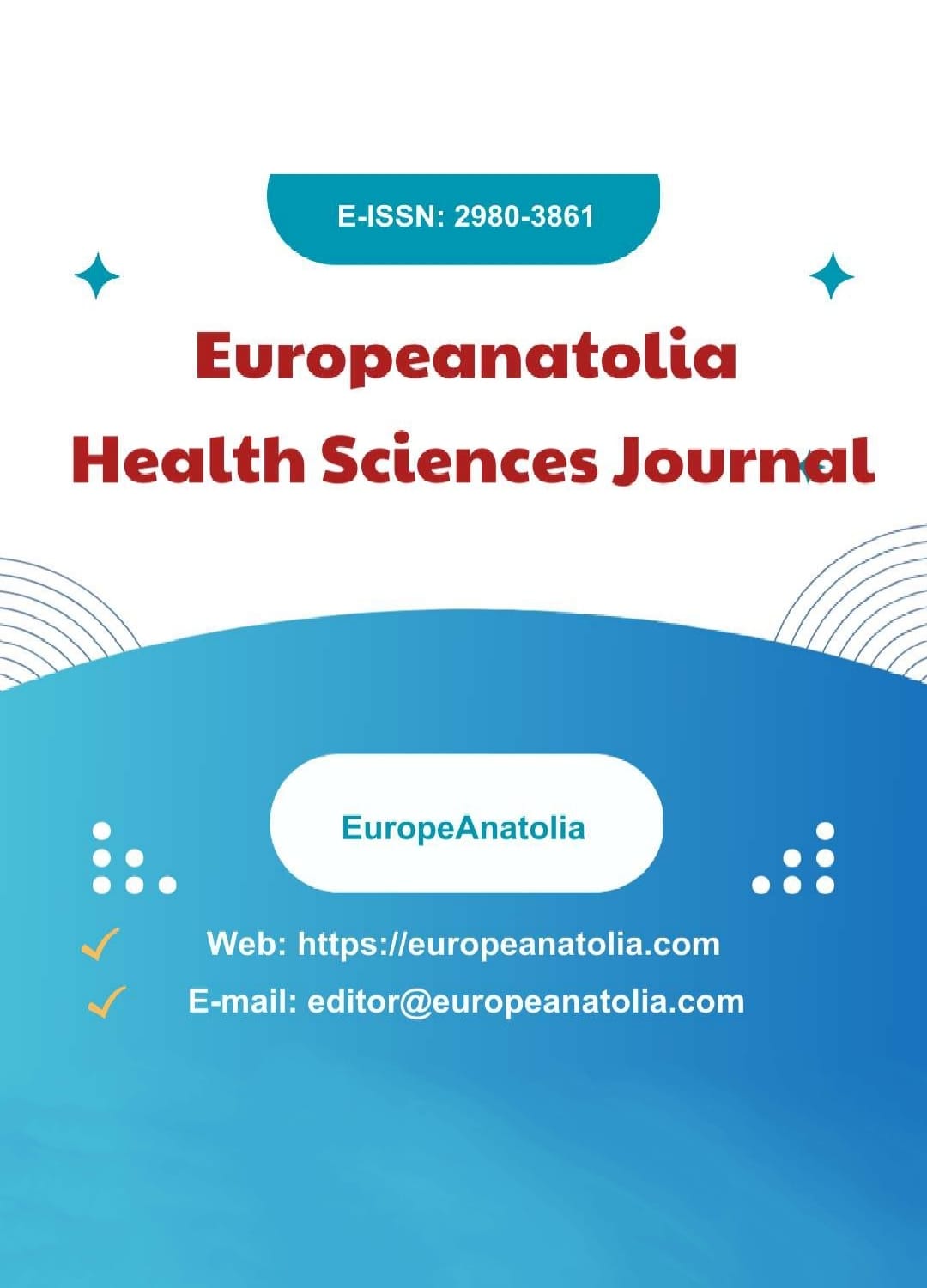Omental Incubation of Tissue-Engineered Small Intestine with Tubularized PLGA in a Rabbit Model
Research Article
DOI:
https://doi.org/10.5281/zenodo.17024971Anahtar Kelimeler:
Tissue-Engineered Small Intestine, Intestinal organoids, Short bowel syndromeÖzet
Introduction and Objective: This study aimed to incubate the tissue-engineered small intestine (TESI) organoids in rabbit omentum with tubularized PLGA and to compare them with a control group.
Method: Twelve adult male white rabbits were equally divided into a study and control group. PLGA-formed 1-cm tubes were coated with 1:100 collagen type 1. Organoid units were isolated with full-thickness biopsies from the small intestine and were seeded onto PLGA polymer. Laparotomy was made by a midline incision and the omentum was prepared for implantation. A cell-seeded polymer tube was stented to secure the tubular structure, wrapped by the omentum, and fixed with unabsorbable sutures as the control group.
Results: Five animals (83.3%) survived both in the study and control groups. Examination of cell suspension on an inverted microscope revealed that the mesenchyme cell was surrounded by epithelial cells, cuboid cells with a centrally located nucleus and large cytoplasm, forming intestinal organoid units. The ratio of viable cells was 95% before seeding on polymers. The gross appearance of the tissue showed the formation of a sufficient vascular supply and an intact tubular structure. Examination of sections obtained from the study group, stained with H+E and Masson showed polymer fibers surrounding intestinal cells, epithelial cells located on the luminal surface, and enterocytes embedded in the connective tissue. Control group sections contained fibrotic tissue around intact polymer fibers.
Conclusion: TESI with orthotopic transplantation of the intestinal organoids provides a reasonable model to obtain intestinal function for the future of the procedure being investigated.
Referanslar
Chandra R, Kesavan A. Current treatment paradigms in pediatric short bowel syndrome. Clin J Gastroenterol. 2018;11(2):103-112. doi:10.1007/s12328-017-0811-7
Zhang T, Feng H, Cao Y, et al. Long-term outcomes of various pediatric short bowel syndrome in China. Pediatr Surg Int. 2021;37(4):495-502. doi:10.1007/s00383-020-04797-8
Carroll RE, Benedetti E, Schowalter JP, Buchman AL. Management and Complications of Short Bowel Syndrome: an Updated Review. Curr Gastroenterol Rep [Internet]. 2016;18(7). Available from: http://dx.doi.org/10.1007/s11894-016-0511-3
Muff JL, Sokolovski F, Walsh-Korb Z, et al. Surgical Treatment of Short Bowel Syndrome-The Past, the Present and the Future, a Descriptive Review of the Literature. Children (Basel). 2022;9(7):1024. Published 2022 Jul 10. doi:10.3390/children9071024
Massironi S, Cavalcoli F, Rausa E, Invernizzi P, Braga M, Vecchi M. Understanding short bowel syndrome: Current status and future perspectives. Dig Liver Dis. 2020;52(3):253-261. doi:10.1016/j.dld.2019.11.013
Lakkasani S, Seth D, Khokhar I, Touza M, Dacosta TJ. Concise review on short bowel syndrome: Etiology, pathophysiology, and management. World J Clin Cases. 2022;10(31):11273–82.
Bianchi A. Intestinal loop lengthening--a technique for increasing small intestinal length. J Pediatr Surg. 1980;15(2):145-151. doi:10.1016/s0022-3468(80)80005-4
Kim HB, Fauza D, Garza J, Oh JT, Nurko S, Jaksic T. Serial transverse enteroplasty (STEP): a novel bowel lengthening procedure. J Pediatr Surg. 2003;38(3):425-429. doi:10.1053/jpsu.2003.50073
Kovler ML, Hackam DJ. Generating an Artificial Intestine for the Treatment of Short Bowel Syndrome. Gastroenterol Clin North Am [Internet]. 2019;48(4):585–605. Available from: https://doi.org/10.1016/j.gtc.2019.08.011
Venick RS. Long-term results of intestinal transplantation in children: survival after 10 years, intestinal function, quality of life. Curr Opin Organ Transplant. 2018;23(2):219-223. doi:10.1097/MOT.0000000000000514
Yui S, Nakamura T, Sato T, et al. Functional engraftment of colon epithelium expanded in vitro from a single adult Lgr5⁺ stem cell. Nat Med. 2012;18(4):618-623. Published 2012 Mar 11. doi:10.1038/nm.2695
Fordham RP, Yui S, Hannan NR, et al. Transplantation of expanded fetal intestinal progenitors contributes to colon regeneration after injury. Cell Stem Cell. 2013;13(6):734-744. doi:10.1016/j.stem.2013.09.015
Sugimoto S, Ohta Y, Fujii M, Matano M, Shimokawa M, Nanki K, et al. Reconstruction of the Human Colon Epithelium In Vivo. Cell Stem Cell [Internet]. 2018;22(2):171-176.e5. Available from: https://doi.org/10.1016/j.stem.2017.11.012
Hewes SA, Wilson RL, Estes MK, Shroyer NF, Blutt SE, Grande-Allen KJ. In Vitro Models of the Small Intestine: Engineering Challenges and Engineering Solutions. Tissue Eng Part B Rev. 2020;26(4):313-326. doi:10.1089/ten.TEB.2019.0334ering
Tullie L, Jones BC, De Coppi P, Li VSW. Building gut from scratch - progress and update of intestinal tissue engineering. Nat Rev Gastroenterol Hepatol. 2022;19(7):417-431. doi:10.1038/s41575-022-00586-x
Kobayashi E. A new stage of experimental surgery for organoid based intestinal regeneration - A review of organoid research and recent advance. Magy Seb. 2022;75(4):261-264. Published 2022 Dec 14. doi:10.1556/1046.2022.40002
Javaid-Ur-Rehman, Waseem T. Intestinal tissue engineering: where do we stand?. Surg Today. 2008;38(6):484-486. doi:10.1007/s00595-007-3671-9
Vacanti JP, Morse MA, Saltzman WM, Domb AJ, Perez-Atayde A, Langer R. Selective cell transplantation using bioabsorbable artificial polymers as matrices. J Pediatr Surg. 1988;23(1 Pt 2):3-9. doi:10.1016/s0022-3468(88)80529-3
Rahmani S, Breyner NM, Su HM, Verdu EF, Didar TF. Intestinal organoids: A new paradigm for engineering intestinal epithelium in vitro. Biomaterials. 2019;194:195-214. doi:10.1016/j.biomaterials.2018.12.006
Hirota A, AlMusawi S, Nateri AS, Ordóñez-Morán P, Imajo M. Biomaterials for intestinal organoid technology and personalized disease modeling. Acta Biomater [Internet]. 2021;132:272–87. Available from: https://doi.org/10.1016/j.actbio.2021.05.010
Collier CA, Mendiondo C, Raghavan S. Tissue engineering of the gastrointestinal tract: the historic path to translation. J Biol Eng. 2022;16(1):1–12.
Laura YM. Tissue engineering for the treatment of short bowel syndrome in children. Physiol Behav. 2018;176(1):139–48.
Liu Y, Cromeens BP, Wang Y, et al. Comparison of Different In Vivo Incubation Sites to Produce Tissue-Engineered Small Intestine. Tissue Eng Part A. 2018;24(13-14):1138-1147. doi:10.1089/ten.TEA.2017.0313
Sugimoto S, Kobayashi E, Fujii M, et al. An organoid-based organ-repurposing approach to treat short bowel syndrome. Nature. 2021;592(7852):99-104. doi:10.1038/s41586-021-03247-2
Kitano K, Schwartz DM, Zhou H, et al. Bioengineering of functional human induced pluripotent stem cell-derived intestinal grafts. Nat Commun. 2017;8(1):765. Published 2017 Oct 10. doi:10.1038/s41467-017-00779-y
Cortez AR, Poling HM, Brown NE, Singh A, Mahe MM, Helmrath MA. Transplantation of human intestinal organoids into the mouse mesentery: A more physiologic and anatomic engraftment site. Surgery. 2018;164(4):643-650. doi:10.1016/j.surg.2018.04.048
Liu Y, Wang Y, Chakroff J, Johnson J, Farrell A, Besner GE. Production of Tissue-Engineered Small Intestine in Rats with Different Ages of Cell Donors. Tissue Eng - Part A. 2019;25(11–12):878–86.
Yanchun L. Comparison of Polyglycolic Acid, Polycaprolactone, and Collagen as Scaffolds for the Production of Tissue Engineered Intestine. Physiol Behav. 2018;176(1):139–48.
İndir
Yayınlanmış
Nasıl Atıf Yapılır
Sayı
Bölüm
Lisans
Telif Hakkı (c) 2025 Europeanatolia Health Sciences Journal

Bu çalışma Creative Commons Attribution 4.0 International License ile lisanslanmıştır.










